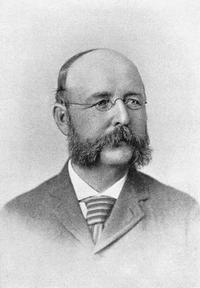John Knowles Paine facts for kids
John Knowles Paine (born January 9, 1839 – died April 25, 1906) was a very important American composer. He was the first American-born composer to become famous for writing big pieces of music for an orchestra. Paine was a key member of a group called the Boston Six. This group helped create the first major concert music by composers from the United States. Other members of the Boston Six included Amy Beach, Arthur Foote, Edward MacDowell, George Chadwick, and Horatio Parker.
Contents
His Life and Music
Paine grew up in a musical family in Maine. His grandfather made musical instruments, and his father and uncles were all music teachers. One uncle played the organ, and another was a composer.
Early Musical Journey
In the 1850s, Paine learned to play the organ and compose music from Hermann Kotzschmar. He wrote his first piece, a string quartet, in 1855 when he was just 16. After his first organ concert in 1857, he became the organist for Portland's Haydn Society. He gave many concerts to earn money for a trip to Europe. He wanted to study music there.
Studying in Europe
When Paine arrived in Europe, he studied organ in Berlin with Carl August Haupt. He also learned about writing music for orchestras from Wilhelm Friedrich Wieprecht. For three years, he traveled around Europe, giving organ concerts. He became well-known as an organist even before he returned to the United States.
A Pioneer at Harvard
Paine came back to the U.S. and settled in Boston in 1861. He became the first University organist and choirmaster at Harvard University. While working there, Paine started offering free classes in music. These classes taught people how to enjoy music and understand music theory. They became the main courses for Harvard's new music department. This was the first music department like it in the United States! Paine was then named America's first music professor. He taught at Harvard until 1905, just one year before he passed away.
Making a Mark on American Music
In 1867, Paine's Mass in D minor, Op. 10 was performed in Berlin. It was very popular and helped him become famous. His music classes at Harvard became a model for other music departments across America. He also helped shape music education through his work at The New England Conservatory of Music. Many important composers, like George Chadwick and Charles Ives, were influenced by his teaching.
Paine was the first guest conductor for the Boston Symphony Orchestra. His music was a favorite with audiences. He is known for starting America's tradition of writing symphonies (large musical pieces for orchestra). He also wrote an oratorio (a large musical work for voices and orchestra) called St Peter in 1872. His Centennial Hymn opened the 1876 Centennial Exposition in Philadelphia. Paine also helped start the American Guild of Organists.
He wrote a book called The History of Music to the Death of Schubert (published in 1885). He also helped edit another book, Famous Composers and their Works (published in 1891). For this book, he wrote chapters about "Beethoven as Composer" and "Music in Germany."
In 1889, Paine made one of the very first music recordings. He recorded on a wax cylinder with Theo Wangemann. Wangemann was experimenting with the new phonograph machine.
Legacy and Recognition
John Knowles Paine was one of the first people to be honored in the American Classical Music Hall of Fame in 1998.
The Grove Music Encyclopedia, a famous music reference, said that Paine "awakened a regard for music among many generations of Harvard men." This means he made many students at Harvard care about music.
Paine Hall, the concert hall for Harvard's music department, is named after him. This shows how important he was in starting music studies at Harvard.
Main Musical Works
Here are some of the important musical pieces John Knowles Paine wrote:
Opera
- Azara (An opera is a play where the story is told mostly through singing, with music played by an orchestra.)
Orchestral Music
- Symphony No. 1, Op. 23
- As You Like It, Overture, Op. 28
- The Tempest, Symphonic Poem, Op. 31
- Symphony No. 2 in A major "In Spring", Op. 34
- Prelude from Oedipus Tyrannus, Op. 35
- Poseidon and Amphitrite: an Ocean Fantasy, Op.44
Chorus and Orchestra
- Freedom, Our Queen
- Domine salvum fac Praesidem nostrum, Op.8
- Mass in D minor, Op. 10
- St. Peter: An Oratorio, Op. 20 (1872)
- Centennial Hymn, Op. 27 (1876)
- Oedipus Tyrannus, Op. 35
- The Realm of Fancy, Op. 36
- Phoebus, Arise!, Op. 37
Organ Music
- Concert Variations on "The Star-Spangled Banner", [Op. 1] – 1861
- Concert Variations on the Austrian Hymn, Op. 3 #1
- Fantasy on Ein feste Burg, Op. 13
- Prelude in B minor, Op. 19 #2
- Fugue in C minor (from Four Pieces)
Hymn Tune
- Harvard Hymn (This tune is used for a special song sung at Harvard graduation ceremonies.)


